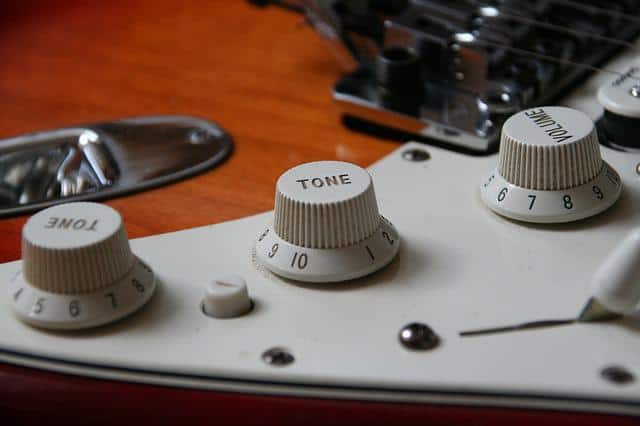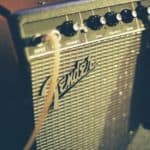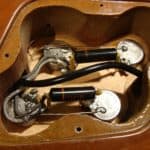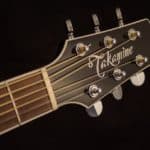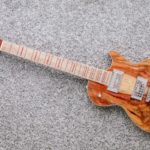Lots of people, online and in real life, think that switching out electronic components for higher-quality replacements can improve a guitar’s sound.
All the guitar’s electronics do, though, is filter out parts of the signal coming from the pickups.
Can new pots or caps make enough difference to be worth the cost and trouble?
Guitar electronics do have a noticeable effect on tone, however not as big as a pickup swap would have. The main variation you will notice between different value capacitors or pots will be on the high-end. The lower the value of a pot, the darker the instrument will sound.
A good guitar tech should be able to handle switching out caps and pots without much trouble. If you want to tackle it yourself, make sure to familiarize yourself with how to solder electrical connections and how to work safely with electrical circuits.
How do guitar electronics affect the tone of a guitar?
A guitar’s internal electronic components create a signal path from the pickup(s) (the source) to the output jack.
The components themselves, as well as the way they’re all connected, filter out parts of that electrical signal so that it sounds different coming out of the amp.
For more about this, check out:
What are the most common guitar electronic upgrades?
- New capacitors (“caps”) to change the character and range of tone adjustment
- New potentiometers (“pots” or knobs) to change the tone and modify how the volume and tone controls respond
- New components and a little rewiring to create a treble bleed
What can you expect from changing the caps on your guitar?
Caps are found in the tone control circuits of a guitar. They don’t play any part in the volume control.
Basics of guitar caps
Materials used in guitar caps
Capacitors in guitars are typically made of:
- ceramics, which are often disc-shaped, have the brightest tone and are the cheapest
- polypropylene, which may look like orange drops or blue drops, and have a fairly bright tone
- paper in oil sometimes called bumblebees for the color-coded stripes they sometimes have, which result in warmer or darker tones, and are priciest
What do capacitors do?
In a guitar, capacitors filter out the higher frequencies in the signal. This has the effect of reducing the brighter, harsher aspects of the guitar’s tone when the signal is converted back into sound by an amp and speaker.
They are wired into the guitar’s tone circuits so that the player can control the tone.
What do the specs and ratings mean?
- microFarads (uF) – capacitance is generally measured in Farads, but guitar circuits only use caps with millionths of Farads of capacity so they are measured in microfarads; typical ratings are .015 uF, .022 uF, and .047 uF
- Volts (V) – the voltage rating indicates the maximum voltage that the capacitor can handle; regular passive guitar pickups only generate small amounts of voltage, much smaller than the limits of most capacitors
What difference does a capacitor make in tone?
When the tone knob is turned all the way up (clockwise from the player’s perspective), the cap theoretically has no effect on the tone. As the player turns down the tone knob, the capacitor has a greater effect on the tone.
A cap’s uF rating makes much more difference in tone than its material. A cap with a higher uF value will make a greater difference in the guitar tone, and the darker the tone will be when the knob is turned all the way down.
What can you expect from changing the pots on your guitar?
What are pots?
Volume and tone knobs on a guitar are connected to potentiometers that are wired into the signal path. Pots are variable resistors that let the player adjust the volume and tone characteristics of the signal.
Pots are measured in kilohms (K). Common ratings are 250K, 500K, and 1,000K (or 1 Megohm). The top brands are CTS and Bourns.
How do pots affect guitar tone?
Volume Control
The pot on the volume circuit primarily affects the amplitude of the signal. Turning the volume knob down decreases signal amplitude and reduces the volume.
Taper
A pot’s taper describes its effect as the control is changed from one extreme to the other. A pot with a linear taper may seem to behave erratically, having little effect through most of its control range but then having an exaggerated effect close to the extremes.
A pot with an audio taper, on the other hand, will behave more as expected, with a smoother audible change as the player adjusts the control.
Tonal Effects
A pot’s resistance value also has the effect of coloring the tone. A signal going through a 500K pot will retain more of the higher frequencies and will have a brighter tone than a 250K pot.
250K pots are often used with single-coil pickups to filter out harsher high frequencies for a warmer tone. 500K pots are commonly matched with humbuckers.
Chris Buck explains it clearly in this video and even goes to the lengths of calling it the cheapest Les Paul tone hack:
No-load pots
Tone pots actually can affect tone even when they’re turned all the way up and theoretically shouldn’t change the tone at all.
No-load pots address this issue by omitting the resistive material on one end, bypassing the pot completely at the clockwise extreme.
No-load pots are used only in tone circuits. The volume would drop out completely at the maximum setting if a no-load pot was used for volume control!
What’s treble bleed and why would you want it?
A volume pot can have the unexpected side effect of cutting higher frequencies when the volume knob is turned down.
This can happen because of the way the circuits are wired, or because of the combination of components used.
A treble bleed mod involves wiring a combination of extra capacitors and resistors in such a way that allows those high frequencies to remain in the signal.
Some gear companies even sell pre-wired treble bleed circuits to make installation as simple as possible.
Is changing the pickup switch worth it?
Generally not. If the guitar sounds ok in all of the possible switch positions, the switch is probably working within design specs. All the switch does is make connections so it’s unlikely that an upgrade will improve anything.
But if you can hear problems, such as muffled tone in some switch positions or sound not coming out when expected, replacing the switch might be the repair you need.
In most cases, upgrading pots, caps, and other electronic components probably won’t make much difference to your guitar’s tone. If everything sounds ok, works, and feels good to play, swapping out parts shouldn’t be necessary.
Replacing pickups will have a lot bigger impact on tone.
Other electronic mods you could add
Although guitar electronics are quite simple, there are some other mods that can be done on your instrument and that are quite popular.
For instance, dummy coil mods are popular in single-coil pickup guitars as a way of preventing their natural hum.
Coil-splitting and coil-tapping are also ubiquitous mods that many newer instruments have factory installed.
These mods allow you to split your humbucker pickups into single coils, and although they don’t sound exactly like regular ones, they can really broaden your tonal palette without the need of switching guitars for that sound.
Phase shift switches also can have a lot of possibilities to add if you like experimenting with new sounds.
The way they work really escapes the scope of this article, but they can unlock even more sounds on your guitar.
Pair them with coil splitting and you will have many more tones than you can possibly use.
Killswitches are more of a gimmick, in my opinion, but I know that some players take them rather seriously.
They are just a button that when pressed down cuts off your guitar signal completely, allowing you to play with it rhythmically and create some interesting choppy robotic sounds.
I’m pretty sure that there are lots of other great guitar electronic mods out there, but I limited myself to mentioning the most common ones.
If you think there’s some important one missing, please mention it in our Facebook community and I’ll be happy to add it!

Hello there, my name is Ramiro and I’ve been playing guitar for almost 20 years. I’m obsessed with everything gear-related and I thought it might be worth sharing it. From guitars, pedals, amps, and synths to studio gear and production tips, I hope you find what I post here useful, and I’ll try my best to keep it entertaining also.

